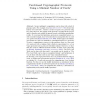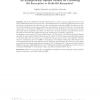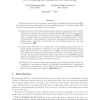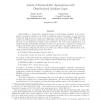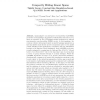ASIACRYPT
2015
Springer
8 years 11 months ago
2015
Springer
Secure multiparty computation can be done with a deck of playing cards. For example, den Boer (EUROCRYPT ’89) devised his famous “five-card trick”, which is a secure two-par...
ASIACRYPT
2015
Springer
8 years 11 months ago
2015
Springer
ASIACRYPT
2015
Springer
8 years 11 months ago
2015
Springer
We show a general connection between various types of statistical zero-knowledge (SZK) proof systems and (unconditionally secure) secret sharing schemes. Viewed through the SZK le...
ASIACRYPT
2015
Springer
8 years 11 months ago
2015
Springer
We solve an open question in code-based cryptography by introducing the first provably secure group signature scheme from codebased assumptions. Specifically, the scheme satisfi...
ASIACRYPT
2015
Springer
8 years 11 months ago
2015
Springer
We introduce a novel concept of dual-system simulation-sound non-interactive zero-knowledge (NIZK) proofs. Dual-system NIZK proof system can be seen as a two-tier proof system. As...
ASIACRYPT
2015
Springer
8 years 11 months ago
2015
Springer
In the past few years, lightweight cryptography has become a popular research discipline with a number of ciphers and hash functions proposed. The designers’ focus has been predo...
ASIACRYPT
2015
Springer
8 years 11 months ago
2015
Springer
Extractability, or “knowledge,” assumptions have recently gained popularity in the cryptographic community, leading to the study of primitives such as extractable one-way func...
ASIACRYPT
2015
Springer
8 years 11 months ago
2015
Springer
Quasi-adaptive non-interactive zero-knowledge (QA-NIZK) proofs is a recent paradigm, suggested by Jutla and Roy (Asiacrypt ’13), which is motivated by the Groth-Sahai seminal tec...
ASIACRYPT
2015
Springer
8 years 11 months ago
2015
Springer
HMAC and its variant NMAC are the most popular approaches to deriving a MAC (and more generally, a PRF) from a cryptographic hash function. Despite nearly two decades of research, ...
ASIACRYPT
2015
Springer
8 years 11 months ago
2015
Springer
In 2012, NIST standardized SHA-512/224 and SHA-512/256, two truncated variants of SHA-512, in FIPS 180-4. These two hash functions are faster than SHA-224 and SHA-256 on 64-bit pla...
